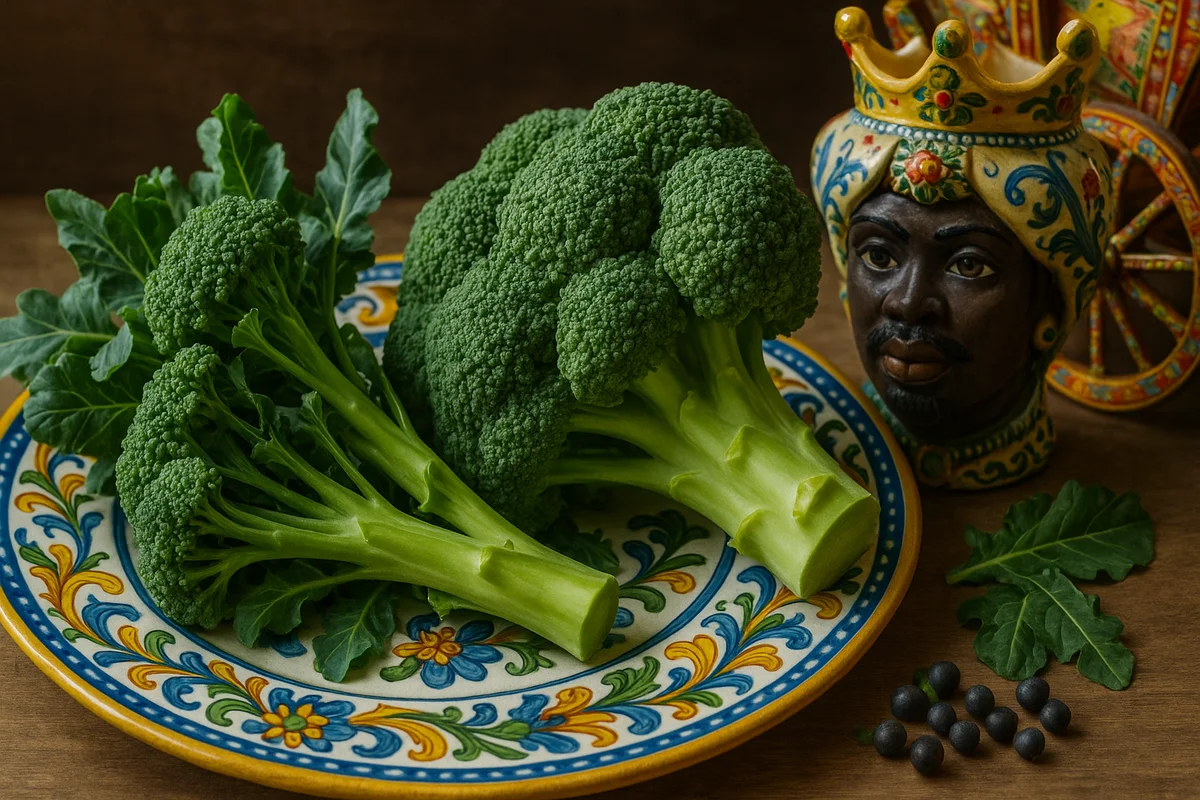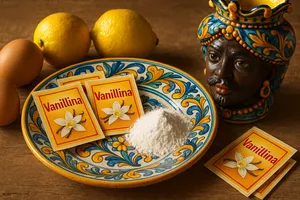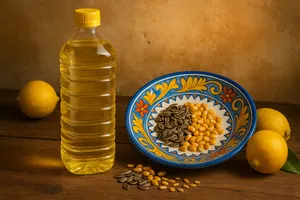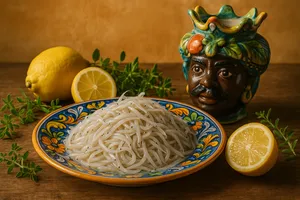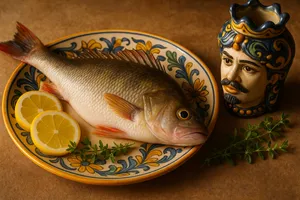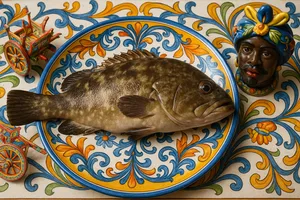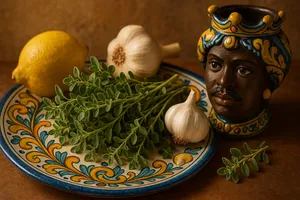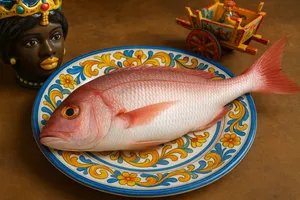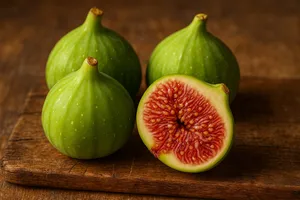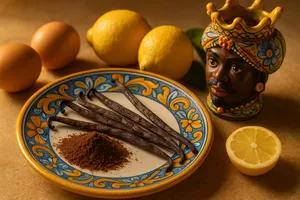Overview
Broccolini, known in Sicily as “sparacelli” or “brocculi” depending on the area, belongs to the Brassicaceae family and is highly appreciated in the island’s cuisine for its delicate, slightly bitter flavour. It consists of the still-tender inflorescences and young leaves of various cabbage varieties, harvested before the flowers fully open.
In Sicily, broccolini is an important element of winter and spring cooking, starring in traditional dishes ranging from pasta to side dishes, soups and gratin preparations. Its versatility and characteristic flavour make it particularly suited to pairing with typical Sicilian ingredients such as anchovies, raisins, pine nuts and toasted breadcrumbs.
Varieties
The generic term “broccolini” encompasses several varieties of vegetables, each with distinctive characteristics.
Cime di rapa
Called “sparacelli” in Sicilian, they are the most widespread and beloved on the island. They feature dark green, serrated leaves and small green inflorescences, sometimes with tiny yellow buds. Their slightly bitter, highly distinctive flavour is particularly appreciated in Sicilian cuisine.
Sicilian broccoli
A local variety with light green or purplish inflorescences, more tender and delicate than cime di rapa. It has a sweeter, less bitter flavour, with broad, fleshy leaves. It is typical of western Sicily.
Friarielli
Although more typical of Neapolitan cuisine, they are also found in some parts of Sicily. These are the inflorescences of a very tender broccoli variety, with a delicate, slightly spicy flavour.
Seasonality
In Sicily, broccolini is available mainly during the cooler months, from November to April, with peak production and quality from January to March. During these months, the inflorescences are more tender, compact and flavourful.
The island’s mild climate allows for abundant and prolonged production compared to other Italian regions. Broccolini harvested in the colder months has a more intense flavour and better texture, while that picked at the end of the season may be more bitter and fibrous.
Nutritional properties
Broccolini is very nutritious yet light, with about 25–30 calories per 100 grams. It is extremely rich in vitamins, particularly vitamin C-at concentrations even higher than citrus fruits-vitamin A, essential for vision and the immune system, and vitamin K, crucial for blood clotting.
It contains notable amounts of folic acid, especially important during pregnancy, and B vitamins. In terms of minerals, it provides good quantities of calcium, iron, potassium and phosphorus.
It is an excellent source of fibre, which supports intestinal regularity, and antioxidants, especially sulforaphane and other sulphur compounds typical of cruciferous vegetables, known for their protective properties. Like all brassicas, broccolini contains glucosinolates, substances responsible for its characteristic slightly bitter taste and recognised for their interesting health benefits.
Culinary use
In Sicilian cooking, broccolini features in numerous preparations that highlight its distinctive flavour.
Pasta with broccoli
The most iconic dish is undoubtedly pasta with broccoli, prepared in several variations. The classic version features broccolini boiled and then sautéed with anchovies, garlic, oil and chilli, then mixed with pasta (usually orecchiette or cavatelli) and topped with toasted breadcrumbs. A Palermo variation adds raisins and pine nuts, creating the traditional sweet-and-savoury contrast.
Pasta with broccoli and sardines
A variation of the famous pasta with sardines, where broccolini replaces or accompanies wild fennel, creating an even richer and more substantial dish.
Stewed broccolini
A simple, flavourful preparation in which broccolini is cooked in a pan with garlic, oil, chilli and a little water until tender. It is served as a side dish, often with sausage.
Broccolini frittata
Boiled and chopped broccolini is mixed with eggs, grated cheese and herbs, then cooked in a pan to make a rustic, savoury frittata that is excellent even when cold.
Soups and broths
Broccolini is a classic ingredient in rustic soups, often combined with potatoes, beans or other legumes. Broccolini and bean soup is a simple yet nourishing dish of the rural tradition.
Gratin broccolini
After an initial boiling, broccolini is arranged in a baking dish, seasoned with oil, garlic, anchovies and a generous sprinkling of breadcrumbs, then baked until a golden crust forms.
Preparation and cleaning
Preparing broccolini requires some care. Start by removing the outer, damaged leaves, keeping only the tender ones. Trim the tougher stems at the base, leaving only the tender parts of the inflorescences and young leaves.
Broccolini should be washed thoroughly in plenty of cold water, soaking it for a few minutes if very dirty and changing the water several times. It is important to rinse well between the inflorescences where soil may be trapped.
For cooking, boil it in abundant salted water for 5–10 minutes, depending on size and desired tenderness. Some prefer to blanch it briefly and finish cooking it in a pan with other ingredients. Avoid overcooking to preserve nutritional properties and maintain a bright green colour.
Buying tips
When buying fresh broccolini, choose bunches with bright, vibrant green leaves, free from yellowing or wilted parts. The inflorescences should be compact and closed, with the buds still tight. If the flowers are open and yellow, the product is not fresh.
The stems should be firm and fleshy, not woody or hollow. Medium-small inflorescences are generally more tender. Avoid bunches with limp, spotted or deteriorating leaves.
In Sicilian markets, broccolini is abundantly available in season, often sold in tied bunches. Local, seasonal produce always ensures greater freshness and flavour.
Storage
Fresh broccolini keeps in the refrigerator for a maximum of 3–4 days, stored in the vegetable drawer, preferably wrapped in a damp cloth or placed in a perforated paper bag. It should not be washed before refrigeration, only before use, as moisture accelerates deterioration.
For longer storage, blanch it briefly, drain well and freeze in portions. Frozen broccolini keeps for 6–8 months and can be used directly in cooked preparations without thawing.
Cooked broccolini keeps in the refrigerator for 2–3 days in an airtight container and can be reheated in a pan to restore flavour.
Pairings
The characteristic slightly bitter taste of broccolini pairs perfectly with savoury, fatty ingredients that balance its bitterness. Classic Sicilian pairings include anchovies, whose saltiness enhances the flavour of broccolini, as well as garlic and chilli, which complete its aromatic profile.
Toasted breadcrumbs are a traditional accompaniment that adds crunch and flavour. In sweet-and-savoury dishes, raisins and pine nuts create a pleasant contrast with the bitterness of the vegetable. Other successful pairings include sausage, pancetta or guanciale, whose fat softens the assertive flavour of broccolini.
As for wine, structured, slightly savoury Sicilian whites such as Grillo or Catarratto pair well with the character of this vegetable.
Curiosities
The Sicilian term “sparacelli” probably derives from the Latin “asparagus”, referring to the shape of the inflorescences, which vaguely resemble asparagus. This name is particularly common in western Sicily, while in the eastern part of the island the term “brocculi” is more widespread.
In Sicilian folk tradition, broccolini was considered a cleansing food and was eaten abundantly at the end of winter to “cleanse” the body after the cold months. It was said that eating broccolini made the blood “lighter” and helped prevent seasonal ailments.
An old Sicilian proverb says: “Quantu su' amari 'i sparacelli, tantu su' boni pi' 'a saluti” (The more bitter the broccolini, the better it is for your health), highlighting popular awareness of the beneficial properties of this vegetable, despite its flavour not always being appreciated by everyone.
In some parts of Sicily, wild broccolini grows spontaneously in fields after the wheat harvest. These wild varieties, called “sparaceddri di campagna”, were highly valued for their more intense flavour and were gathered by women during countryside walks.
Pasta with broccoli has an interesting history: born as a humble dish of rural cuisine, it has become a symbol of Sicilian gastronomy, to the point of being served in refined restaurants where creative chefs offer revisited versions while maintaining respect for traditional ingredients.

